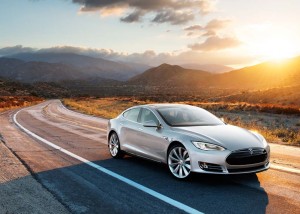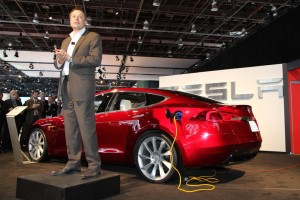The company can’t build cars fast enough to supply demand, and investors can’t get enough, either, driving Tesla Motor stock up nearly six-fold since the beginning of the year. Nonetheless, founder and CEO Elon Musk clearly seems frustrated by critics who continue to focus on issues like battery range and charging times.
So, Musk is about to set out on a cross-country journey meant not only to give his family a vacation but to also help put an end to the issue of range anxiety – at least when it concerns the Tesla Model S. By the numbers, the South African-born entrepreneur plans to spend six days driving 3,200 miles with five kids in tow.
But the figures that really matter concern the estimated 90 minutes a day – or nine hours in total – that Musk expects to spend charging up his Model S sedan using the rapidly expanding network of so-called Supercharger stations Tesla is installing across the country.
“Should go long way in dispelling range anxiety worries,” tweeted Musk, an inveterate user of the Twitter service whenever he wants to reach fans and the media. “At 1.5 hrs/day, we will only ever need to charge when stopping anyway to eat or sightsee, never just for charging itself.”
Musk first raised the idea of doing a cross-country journey earlier this year in the wake of a brouhaha over a story in the New York Times. Reporter John Broder questioned the ability to drive a Model S from Washington, D.C. to Boston using the limited supercharger network available at the time, and noted that his test vehicle had to be delivered to the second station on a flatbed truck.
Defying the conventional wisdom never to attack someone “who buys ink by the barrel,” Tesla’s Musk took the Times on and eventually got the newspaper to concede mistakes were made during the review drive.
(Investors plug back in after Tesla delivers another earnings surprise. Click Here for more.)
Nonetheless, the flap continued to highlight concerns about the limitations of electric vehicles – even among other battery-car manufacturers. This week, for example, Bob Carter, the senior vice president overseeing automotive operations for Toyota in the U.S. suggested battery-cars won’t “have a significant role to play (until) battery and charging systems improve significantly from where they are today.”
Ironically, Toyota turned to Tesla to provide the underlying electric drive system for the Japanese maker’s new RAV4-EV model.
(Tesla will also offer battery-swap option. Click Herefor the story.)
Unlike most of the battery vehicles now on the market – which are typically limited to under 100 miles per charge — Tesla Model S buyers have the option to purchase extended-range battery packs that can deliver almost 300 miles under ideal conditions. In fact, the maker dropped the base, 150-mile sedan when buyers almost uniformly opted up to the 230-mile mid-range or 85 kilowatt-hour maximum-range battery. Of course, as with all electric vehicles, such options carried a steep price, a well-equipped Model S – like the one Musk and family will drive across country — going for over $100,000.
A large battery pack alone wouldn’t solve all the problems of an electric vehicle, however. Depending on the type of home charger a customer uses, the long-range version of the Model S can take as much as the better part of a day to recharge if its battery pack were completely run down.
Tesla’s answer was to come up with the Supercharger network. Known technically as a Level III system, it uses 480-volt direct current with computer controls designed to cut charging times substantially while minimizing wear-and-tear on the battery pack. The system can give an 80% “fill-up” to a Model S in roughly 45 minutes, which suggests Musk anticipates charging up twice a day on his family adventure.
Tesla recently announced it will significantly expand the Supercharger network from its original plans, meaning 100s dotting the U.S. and parts of Canada by mid-decade. The goal is to have one within a minimum 100 miles of every Tesla owner in the country, Musk noted.
(For the full story on the Supercharger network, Click Here.)
Meanwhile, there are plenty of other Level III charging systems going in across the country, some set up by local or state government agencies, others operated by commercial firms, such as eVgo, hoping to catch in on the growth of the battery car market.
In another tweet, Musk noted he has finished planning out his route. It’s a bit more complicated than what the owner of a gas-powered vehicle might need, limiting the family’s ability to take a spontaneous detour to check out a newly discovered tourist attraction, for example. But the more fast chargers are added, the trip should suggest, the more freely battery cars will be able to roam U.S. roads.



Although many pundits have argued that electric vehicles are not yet ready for prime time, Elon Musk is moving the needle in ways that traditional car companies (and even start-ups like Fisker) have not. And although his style is somewhat brash, his boldness may be what it takes to make electric vehicles a reality not only for Americans, but for the world. In the future, we may look back and view him as the Henry Ford of the twenty-first century.
Elon is brash and his deception is highly unlikely to sway anyone but the clueless. He knows full well that EVs have a problem with range so he wants to drag his family along to pretend that a normal family is going to drive miles out of their normal route to find a charging station and then spend 20 minutes to an hour for a partial recharge of the batteries which will limit the distance before the next recharge is required.
He’ll have all kinds of company video and probably media too in an effort to show his carefully orchestrated scheme is typical of what a reasonable commuter would be willing to accept, when in fact it’s anything but what a typical commuter would even consider acceptable.
The reality of the impracticality of the recharging or replacing of batteries will get lost is the circus act and Elon is a master of deceit. Many people who have already purchased EVs based on the hype, have come to understand just how impractical they are and that electricity ain’t free any more than gasoline is.
It’s a stretch for most people to use an EV for city travel but it’s preposterous to try and convince people they are practical for long distance use.